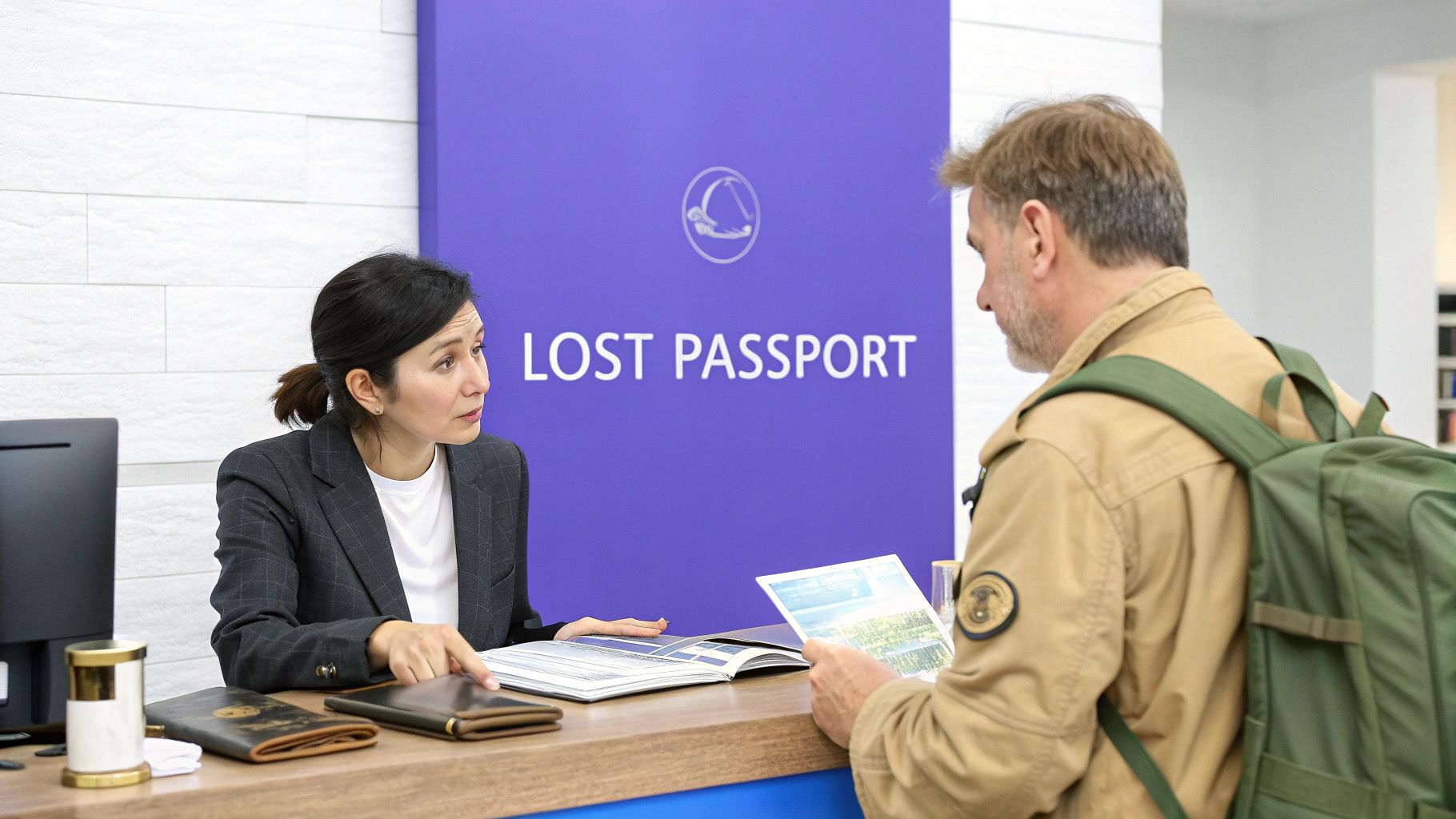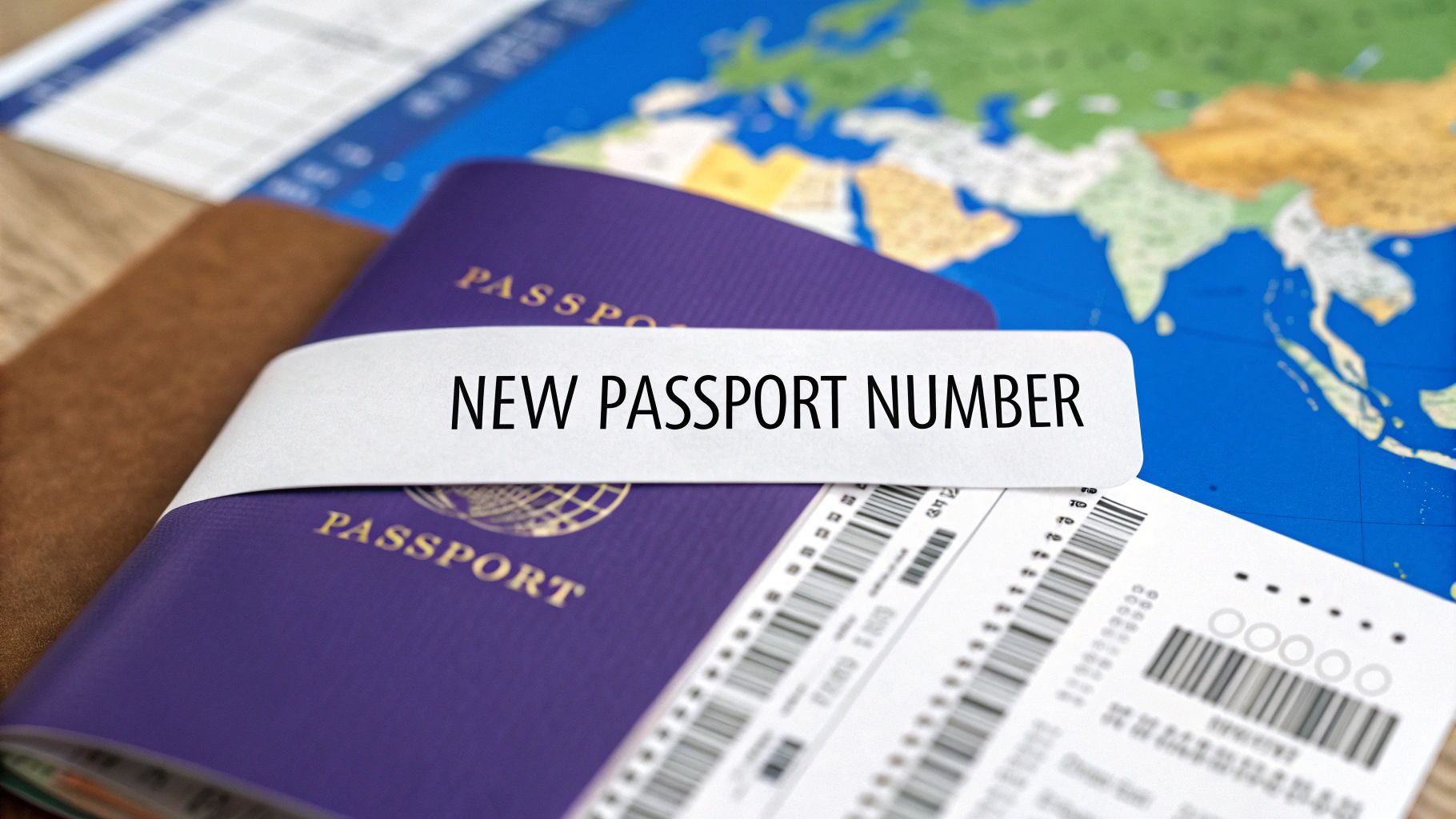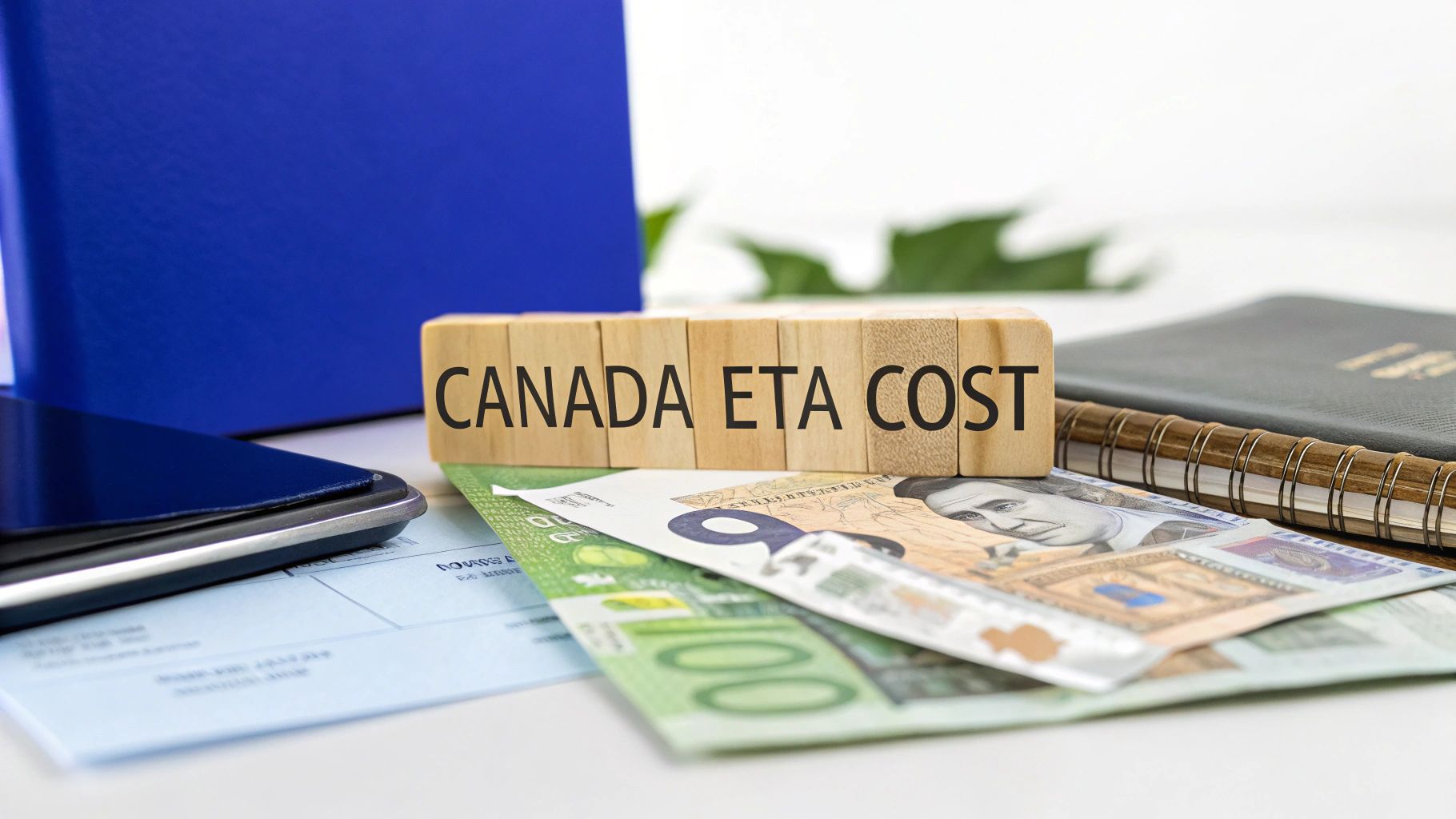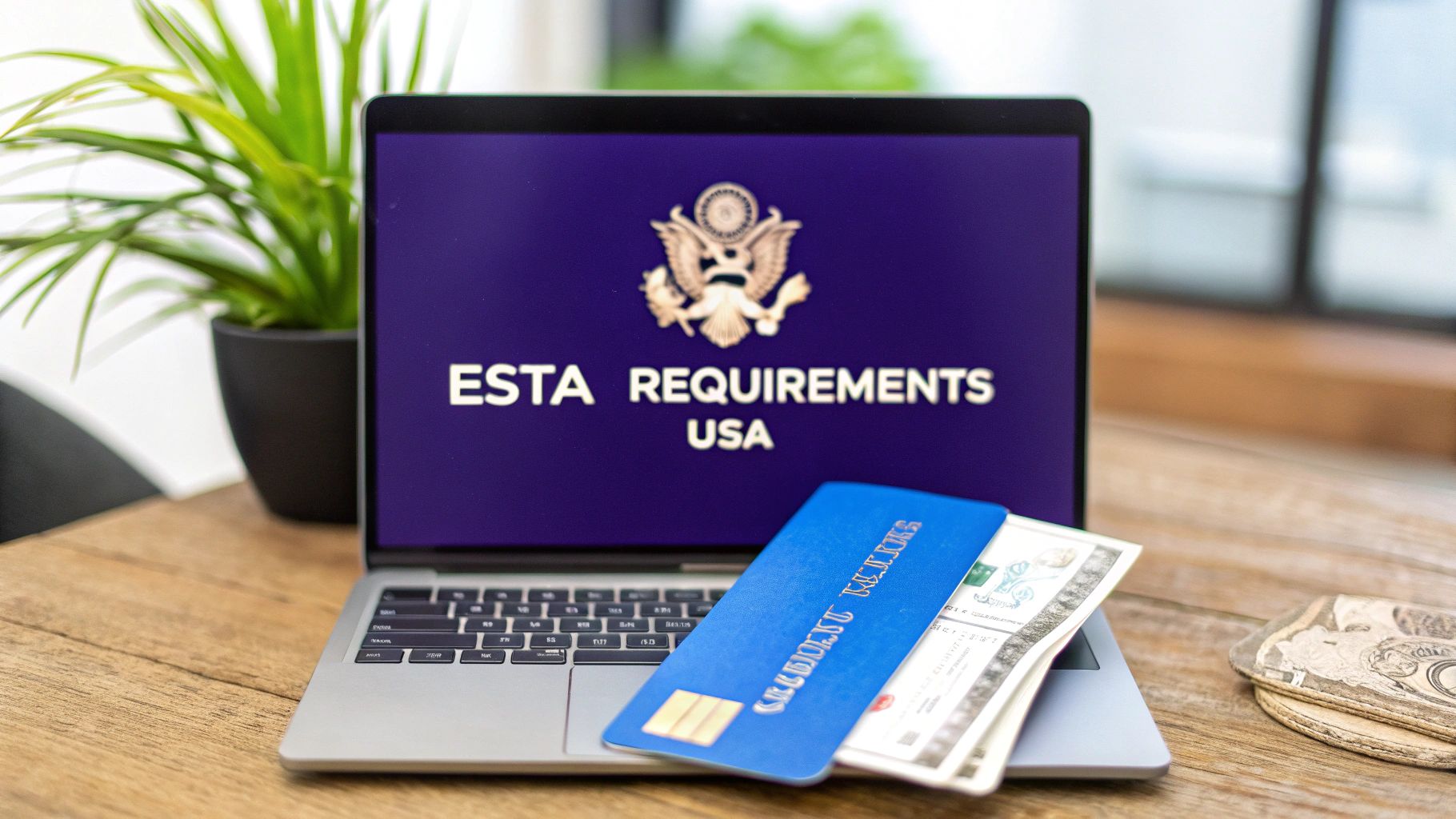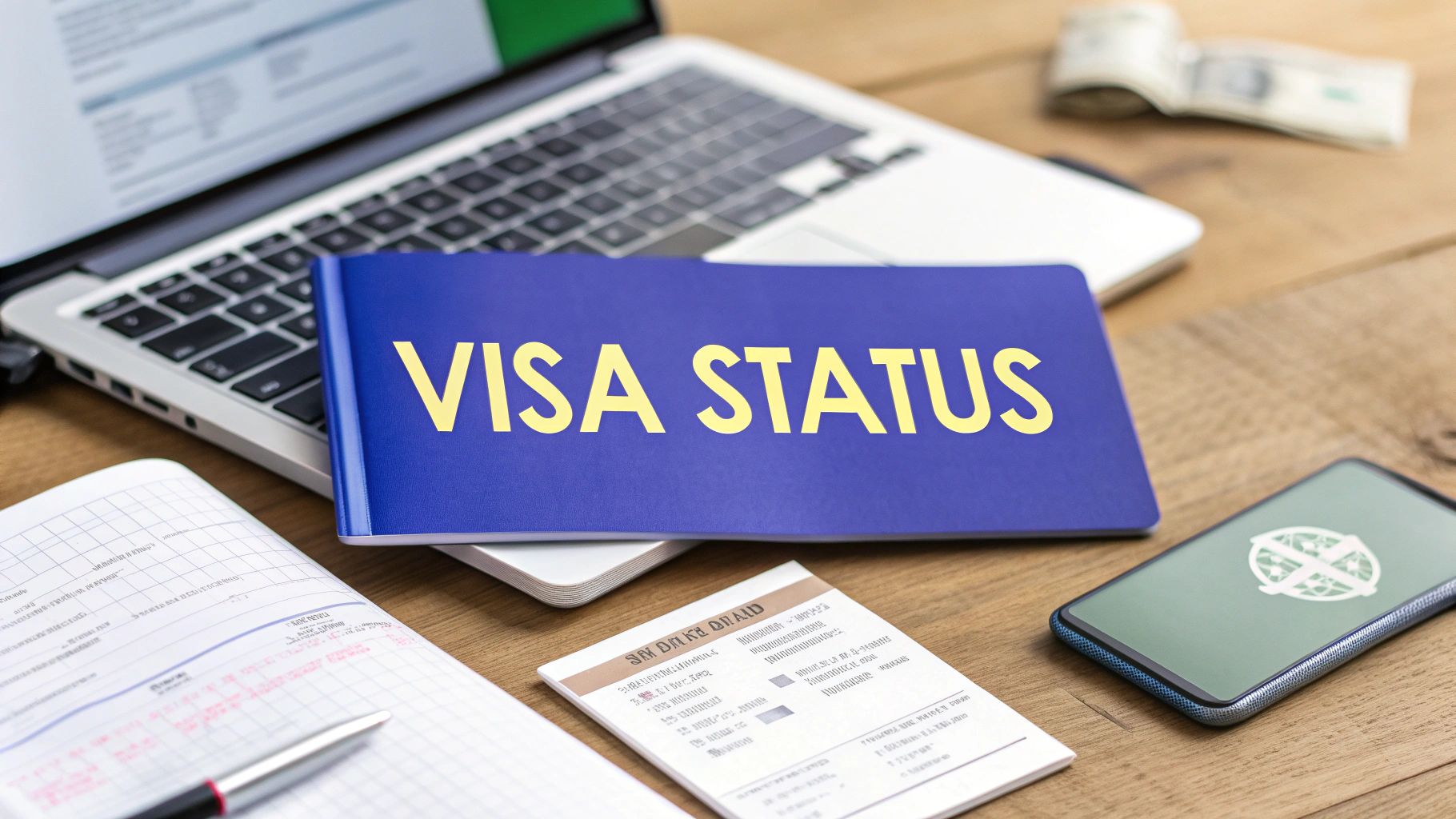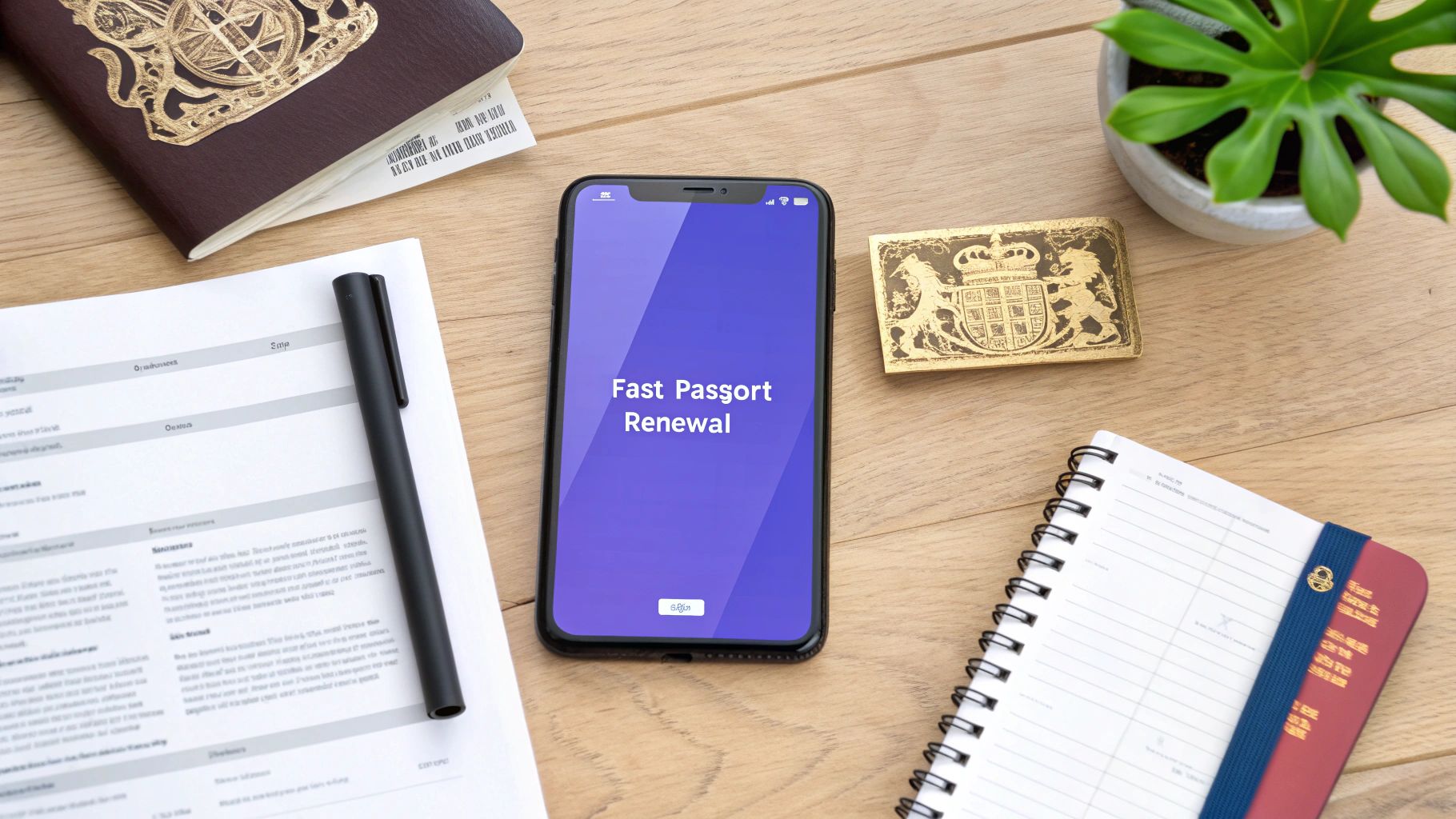
Renewing Passport in UK: Easy Guide to Get Yours Fast
Getting your UK passport renewed is one of those tasks that's easy to put off, but it’s a surprisingly simple process these days. You can handle everything online or, if you prefer, with a paper form. For almost everyone, the online service is the way to go—it’s cheaper and usually quicker.
The most important thing? Don't leave it until the last minute. Starting well before you plan to travel is the secret to avoiding any stress or unexpected hiccups.
Why Renewing Your Passport Early Matters
It’s tempting to delay renewing your passport until a trip is booked, but that can be a costly mistake. Timing is everything.
A detail that catches so many travellers out is that many countries require your passport to be valid for at least six months after you’re scheduled to leave. Renewing with plenty of time to spare means you'll clear these international entry rules without any last-minute panic.
On top of that, HM Passport Office processing times aren't set in stone. They can change a lot, especially during busy holiday periods. While many applications get sorted in a few weeks, the official advice is to allow up to ten weeks. Starting early gives you a comfortable safety net for any potential delays, like if your photo gets rejected or they need more information from you.
Understanding the Renewal Landscape
Knowing your options is the first step to a smooth renewal. It's not just about filling out a form; it's about choosing the right method for you and having everything ready to go.
Here's a quick look at what you need to think about:
- Online vs. Postal: The digital application is now the standard. It’s cheaper and generally faster. The paper form is still available, but it costs more and can take longer to process.
- Get Your Documents Ready: Before you even start, you'll need your old passport, a photo that meets the rules (digital or printed), and a way to pay. Having these ready makes the actual application a breeze.
- Know the Timelines: Standard renewals are not guaranteed to be quick. If you have an urgent trip coming up, you might need to look into the 1 week Fast Track service, which comes with a higher fee.
Think of renewing your passport as regular travel maintenance, not just a task for a specific holiday. A proactive approach is always the best strategy and saves a lot of headaches later on.
Ultimately, renewing your UK passport is a straightforward job when you know what to do. By applying early and understanding your options, you'll be set for a successful renewal, ready for your next adventure without any preventable drama.
Confirming Your Eligibility for Renewal
First things first, let’s make sure a renewal is actually what you need. It’s a common trip-up, but getting this step wrong can send you down the completely wrong path, costing you time and money. HM Passport Office has very specific rules to separate a straightforward renewal from a first-time application or a more complex update.
So, what is a "renewal"? Simply put, it's for replacing an adult or child passport that's about to expire or has recently expired. The most important part? You must have your most recent passport in your possession to send with your application. If it’s been lost or stolen, you’ll need to report it and apply for a replacement—that’s a totally different process.
Key Conditions for a Standard Renewal
To keep things simple and quick, your situation needs to tick a few boxes. These rules are in place to make sure your identity and personal details haven't changed so much that you need a whole new application from scratch.
You’re generally good to go if:
- You still have your previous passport and can send it in.
- Your passport isn’t badly damaged (a bit of normal wear and tear is fine).
- Your name, date of birth, and other key details are exactly the same as on your old passport.
- The passport was issued after December 31, 2003, and you were 16 or older at the time.
If you’ve changed your name—whether through marriage, divorce, or a deed poll—you can't use the standard renewal service. That requires a different application to update the details on your passport.
Distinguishing Between Adult and Child Renewals
The rules for children are a bit different, and it pays to know the distinction. While an adult passport lasts for 10 years, a child’s passport is only valid for five years. Because a child's appearance changes so much, their "renewal" is treated more like a fresh application each time.
For a deep dive into that process, check out our guide on passport renewal requirements for a minor.
One of the most common mistakes people make is underestimating what counts as "significant damage." We’re not talking about a few scuffs. A torn cover, missing pages, or a damaged photo page will almost certainly get your renewal application rejected. In that case, you'd need to apply for a replacement instead.
Taking a moment to confirm your eligibility is the best thing you can do to start the process smoothly. If your passport is intact, your details are the same, and you have it handy, you’re all set for a standard renewal. If not, you’ll need to follow the official guidance for a replacement or a first-time application.
A Practical Checklist for Your Application
A smooth renewal really comes down to having the right documents and a good photo ready to go. Think of it as a pre-flight check before you hit 'submit'—getting these details right is the single best way to avoid the simple mistakes that cause most delays.
The most important item is, of course, your current passport. You'll need to physically send this to HM Passport Office, so make sure you know where it is and that it's safe.
After that, the requirements change a little depending on how you apply, but the real star of the show is the photograph. This is where so many applications get tripped up.
Mastering the Passport Photo Requirements
For an online application, you’ll need a digital photo. You can get a code from a photo booth or have a friend help you take one at home. Just be warned: if you take it yourself, the rules are incredibly strict.
Most rejections come from simple, avoidable errors. This chart breaks down the top three things that catch people out.
As you can see, bad backgrounds and shadows are behind the vast majority of photo failures. You need a plain, light-coloured wall with no patterns, and the light has to be even so there are no shadows on your face or behind you.
If you're applying by post, you'll need two identical printed photos. These must be professionally printed (you can't just use your printer at home) and follow the exact same strict rules.
Key takeaway: Don't smile or frown. Your expression has to be totally neutral with your mouth closed. Take your glasses off, too, unless you have a medical reason not to—and even then, you might need to provide a note explaining why.
Assembling Your Supporting Documents
Once your photo is sorted, the rest is pretty straightforward. A simple renewal usually just requires your old passport, but you need to be ready for other situations.
If you're changing your name or renewing for a child, for instance, you'll have more paperwork to include. For a general idea of what's often needed for UK entry processes, our guide on the documents needed for a UK visitor visa can provide some useful context.
One document that sometimes catches people by surprise is the countersignature. You’ll need to get a professional who has known you for at least two years to sign your form and one of your photos if:
- You are renewing a passport for a child under 12.
- Your appearance has changed so much you’re unrecognisable from your last photo.
- Your old passport was lost, stolen, or badly damaged.
With over four million British passports set to expire in 2025, getting these details right is more critical than ever to avoid being stuck in a queue. Since nearly one in ten Brits admit to missing a holiday because of passport problems, a little prep work now can save a lot of headaches later.
Choosing Between an Online and Postal Application
When you're ready to renew your UK passport, you’ve got two paths to choose from: digital or traditional paper. Your decision here directly affects how much you'll pay, how long you'll wait, and how much hassle is involved.
Let’s be clear: the government strongly nudges everyone towards the online application, and for good reason. It’s built to be the quicker, cheaper, and more streamlined option for most people.
You’ll fill out the forms on the GOV.UK website, pay online, and upload a digital photo. Because your information goes straight into the system, there’s less room for human error, which often means a faster turnaround.
The whole document process is simpler, too. While you do still need to mail them your old passport, you get to skip the headache of getting perfectly sized printed photos. You can also track your application's progress from start to finish. If you want to make sure your digital submission goes off without a hitch, it helps to know how to scan your passport the right way.
When the Postal Application Makes Sense
So, with all the benefits of going digital, why does the paper application still exist?
It remains a vital option for anyone who isn't comfortable with online forms or doesn't have easy access to a digital camera or smartphone. You can just grab a paper form from a Post Office and fill it out the old-fashioned way.
The postal route also offers the ‘Check & Send’ service at participating branches. For an extra fee, a Post Office employee will give your form and photos a final check to ensure everything meets the strict guidelines before it’s sent. This is a brilliant safety net, significantly cutting down the risk of rejection due to a simple mistake. It's a popular choice for those who just want that face-to-face reassurance.
The trade-off is straightforward: the postal service costs more and almost always takes longer. All that manual handling—from posting the form to someone physically typing your details in—adds extra time to the process.
Comparing Your Options Head-to-Head
To help you decide which route is right for you, I’ve put together a quick comparison of the key differences.
UK Passport Renewal Methods Compared
This table breaks down the main features of the online and postal application methods, giving you a clear, side-by-side view to inform your choice.
| Feature | Online Application | Postal Application |
|---|---|---|
| Standard Adult Fee | Lower Cost (e.g., £88.50) | Higher Cost (e.g., £100) |
| Typical Processing | Faster (often within 3 weeks) | Slower (you'll need to allow extra time) |
| Photo Submission | Digital upload from your phone or computer | Two printed, compliant photos required |
| Convenience | Apply from anywhere, 24/7 | Requires getting and filling out a paper form |
| Error Checking | Built-in checks catch some mistakes instantly | Relies entirely on your own accuracy or Check & Send |
| Best For | Tech-savvy users who want speed and savings | Those who prefer paper forms or want expert help |
So, what’s the verdict?
For most people renewing a passport today, the online method is the obvious winner. It’s cheaper, faster, and just more convenient. But if you value the peace of mind that comes with the ‘Check & Send’ service or simply aren’t comfortable with digital forms, the postal application is still a reliable—if slower—alternative.
Passport Renewal Fees and Timelines Explained
Let's get straight to the two biggest questions everyone asks: how much will this cost, and how long will I be waiting? Getting these sorted is key to a stress-free renewal.
The price tag for your new passport really comes down to how you apply. Going the online route isn't just quicker, it’s also easier on your wallet. A standard adult renewal online costs £88.50, but if you prefer the old-school paper form, that'll set you back £100. It's a clear nudge to go digital if you can.
Understanding Standard Processing Times
So, how long is this actually going to take? While things have gotten more efficient, you still need to plan ahead.
Right now, as of early 2025, most people are seeing their new passports arrive in about three to four weeks. However, the official advice from HM Passport Office is to allow up to ten weeks, especially if you're applying during the busy travel seasons. You can find more on this by checking out the latest processing time insights.
That ten-week buffer isn't just a suggestion—it's your safety net against having to cancel a trip. And if you're applying from outside the UK, the process can look a bit different. Our guide on renewing a UK passport in the USA breaks down what you need to know.
When You Need Your Passport Urgently
What happens if you just don't have ten weeks? If you've got a trip right around the corner, there are a couple of faster options, but they do come at a premium.
- 1 week Fast Track: This is the go-to choice for many. It gets your new passport delivered within a week of your in-person appointment at a passport office.
- Online Premium: Need it even faster? This service can get you a new passport at your appointment, sometimes in just a couple of hours. Just know it’s only for simple adult renewals—no name changes or lost passport replacements.
Is the extra fee worth it? It really comes down to peace of mind. If you have non-refundable flights booked, paying a bit more to have your passport in hand is often a no-brainer.
A quick word of advice: these urgent appointments get snapped up fast, especially before school holidays. You have to book and pay for your slot online, and make sure you have everything ready—including your old passport—when you go. And remember, these speedy services are only for people applying within the UK.
Preparing for International Travel After Renewal
Got your new passport? Fantastic. But before you start packing, there's one more crucial step that many travelers miss. A lot of countries, including the UK, now require visa-exempt visitors to get an Electronic Travel Authorisation (ETA) before they even board the plane. Think of it as a digital green light for your trip.
It’s a smart move to double-check the entry requirements for any country on your itinerary right after your passport is renewed. If you're not a British citizen but are planning a trip to the UK, you’ll likely need to sort out a UK ETA application.
Securing Your UK ETA with Confidence
Navigating travel authorisations can feel a bit overwhelming, but it doesn't have to be. For example, if you're planning a trip from down under, you might find a comprehensive guide for traveling to the UK from Australia useful for getting the big picture.
When it comes to the application itself, though, small mistakes can cause big headaches. That’s where a third-party application assistance provider can be incredibly helpful.
To simplify your ETA application and increase your chances of approval, consider using AssistEntry—their experts guide you through the entire process, starting from just $79.
What’s the benefit? Their team provides full verification of your application before submission, checking for common errors and ensuring compliance. This kind of expert handling significantly increases your chances of approval and helps you avoid the simple mistakes that could delay or even derail your travel plans.
For more tips on getting all your ducks in a row for your next adventure, be sure to check out our article on how to prepare for international travel.
Got Questions About Your UK Passport Renewal?
Even when you think you have it all figured out, a few last-minute questions always seem to pop up. Let's tackle some of the most common ones to clear up any lingering doubts.
Can I Travel While My Passport Is Being Renewed?
Unfortunately, no. You can't travel internationally while your passport is with HM Passport Office.
Your old passport has to be sent in with your renewal application, which leaves you without a valid travel document until the new one arrives. Plan accordingly!
What Happens If My Passport Photo Is Rejected?
If your photo doesn't quite meet the strict government guidelines, HM Passport Office will get in touch via email or post to ask for a new one.
This will definitely delay your application, which is why it's so crucial to get that photo right the first time. Double-check the requirements before you snap the picture.
How Do I Track My Passport Application Status?
You can keep an eye on your application's progress using the official online tracker on the GOV.UK website.
All you need is the application reference number you were given when you submitted everything. This will give you real-time updates on where things stand.
Do I Get My Old Passport Back After Renewal?
Yes, your old passport will be returned to you, though it will be officially cancelled. For security reasons, it's usually sent in a separate envelope from your new passport. Don't panic if they arrive a few days apart—that's completely normal.
Keep in mind that passport fees have changed. As of April 2025, the cost to renew a UK passport went up. Adults now pay £94.50 for online applications and £107 if applying by post. You can read more about the rising costs of passport renewal and how different service levels are affected.
Once your new passport is in hand, don't forget to check if you need a travel authorisation for your next trip. Many visitors heading to the UK now need an Electronic Travel Authorisation (ETA).
To make your UK ETA application simple and avoid delays, consider using a professional service. For an error-checked application and expert guidance, visit AssistEntry's UK ETA page. Their services start from just $79 (all costs included) and can give you peace of mind for your upcoming travels.
